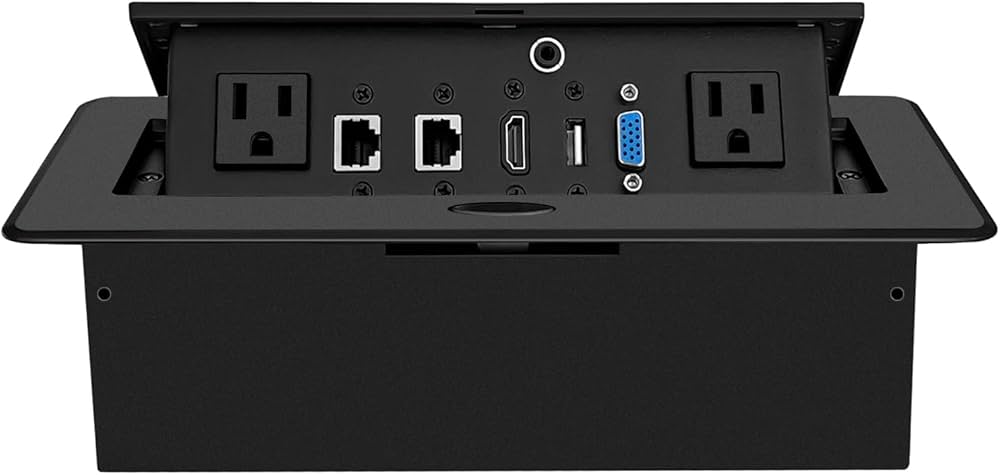In today’s fast-paced and ever-evolving office environment, technology plays a crucial role in boosting productivity and enhancing collaboration. One essential element that many modern offices overlook is the Connectivity Box for desks and conference rooms. These convenient solutions are designed to streamline connections, improve efficiency, and reduce the clutter of wires and cords. But why should you consider upgrading your office with one? Let’s dive into the benefits and what makes these devices so vital for a modern workspace.
1. Introduction: Why Connectivity Matters
Have you ever felt frustrated by a tangled mess of cables underneath your desk or struggled to find the right port to plug in a device? You’re not alone! As businesses increasingly rely on technology, connectivity is now more important than ever. It’s about more than just plugging in a laptop; it’s about creating an environment where work can flow seamlessly without unnecessary disruptions. That’s where the Connectivity Box comes into play.
2. What is a Connectivity Box?
So, what exactly is a Connectivity Box? Imagine it as the hub of your desk or conference table. It’s a compact unit that offers multiple ports—USB, HDMI, Ethernet, and even power outlets—all in one neat package. No more stretching cables across the room or crawling under the table to find an outlet. Whether for individual desks or large meeting spaces, a Connectivity Box brings everything together in one central spot.
3. The Role of Connectivity in Modern Offices
In an era where remote work, hybrid meetings, and real-time collaboration are the norms, the role of connectivity has skyrocketed in importance. Every modern office setup requires efficient access to power, data, and video signals. Connectivity solutions make this happen without disrupting the flow of work. A poorly connected office leads to delays, miscommunication, and often wasted time—things no business can afford.
4. Benefits of Using Connectivity Boxes
Why make the switch to a Connectivity Box? Here are a few standout benefits:
- Declutter Your Workspace: Say goodbye to unsightly cables hanging around your desk or conference table.
- Increased Productivity: Easily connect all devices without searching for available ports.
- Enhanced Collaboration: Multiple users can connect to a single Connectivity Box, making meetings smoother and more efficient.
- Professional Appearance: A tidy, organized workspace leaves a lasting impression on both employees and clients.
5. How Connectivity Boxes Declutter Desks
One of the most obvious advantages of a Connectivity Box is its ability to declutter desks. Offices are often plagued by a web of wires, chargers, and adapters that not only look messy but also create potential hazards. By integrating all necessary connections into one compact box, you eliminate the chaos and simplify daily tasks. Think of it like a toolbox for your electronics, keeping everything in its place.
6. Enhancing Conference Rooms with Technology
Imagine walking into a conference room and needing to connect your laptop to a projector, power source, and Ethernet—all within seconds. Without a Connectivity Box, this scenario can quickly turn into a nightmare of tangled cables and frustration. However, with a Connectivity Box installed, it’s as simple as plugging in. This ensures that meetings start on time, run smoothly, and focus on collaboration instead of tech issues.
7. Types of Connectivity Boxes for Desks
Not all desks are created equal, and neither are Connectivity Boxes. There are several types available depending on your needs:
- Basic Boxes: Offering standard ports like USB and power outlets.
- Advanced Models: Featuring HDMI, Ethernet, and even wireless charging capabilities.
- Built-in Boxes: Seamlessly integrated into the desk for a clean, minimalist look.
8. Types of Connectivity Boxes for Conference Rooms
Conference rooms require a different set of features. Here are the types you might find:
- Tabletop Boxes: Portable and ideal for spaces where flexibility is needed.
- Pop-up Boxes: These remain hidden until needed, then pop up with the press of a button.
- Fixed Installations: Permanently built into the conference table, offering a professional and organized solution for meetings.
9. How to Choose the Right Connectivity Box
Choosing the right Connectivity Box for your office depends on a few factors:
- Number of Users: Will it be used by just one person, or will multiple people need access at once?
- Devices: Consider the types of devices that will need to be connected (laptops, phones, projectors, etc.).
- Space: How much room do you have? Some boxes are larger and designed for conference tables, while others are compact and perfect for individual desks.
10. Installation Tips and Considerations
Installing a Connectivity Box can be a DIY project or one that requires professional help, depending on the complexity of the setup. Here are a few tips:
- Placement is Key: Make sure the box is easily accessible but not in the way.
- Check Compatibility: Ensure the ports and connections meet the needs of your devices.
- Cable Management: Take time to properly route and hide cables for a clean installation.
11. Budget-Friendly Connectivity Box Options
Worried about breaking the bank? There are budget-friendly options available that provide great features without the hefty price tag. Look for basic models that cover your essential needs or consider investing in a more advanced version that will last longer and offer more flexibility as your office grows.
12. Key Features to Look for in a Connectivity Box
When shopping for a Connectivity Box, keep an eye on these key features:
- Variety of Ports: More ports mean more flexibility.
- Durability: Look for high-quality materials that can withstand daily use.
- Wireless Charging: Some advanced boxes come with wireless charging pads for smartphones.
13. Maintenance and Longevity of Connectivity Boxes
Once installed, a Connectivity Box requires very little maintenance. To ensure longevity:
- Keep It Clean: Dust can accumulate in the ports, so wipe it down regularly.
- Avoid Overloading: Don’t plug in more devices than the box can handle to prevent overheating.
- Test Regularly: Make sure all ports are functioning correctly by testing them occasionally.
14. Real-Life Examples of Connectivity Box Integration
Many modern offices have already benefited from the integration of Connectivity Boxes. For example, tech companies often install them in their meeting rooms to facilitate real-time collaboration. Similarly, co-working spaces use Connectivity Boxes to provide easy access to power and data for multiple users at once.
15. Conclusion: The Future of Office Technology
In conclusion, upgrading your office with a Connectivity Box is more than just a practical decision it’s a step toward a more organized, efficient, and tech-savvy workspace. As technology continues to advance, having the right infrastructure in place will become even more crucial. The future of office design lies in seamless connectivity, and with a Connectivity Box, your office will be ready for whatever comes next.




